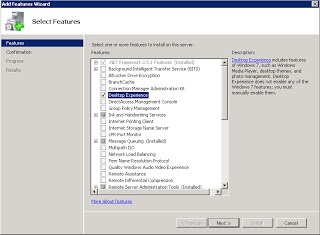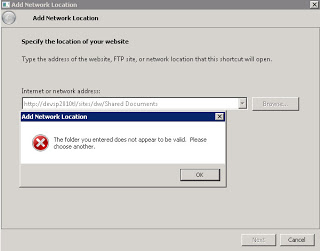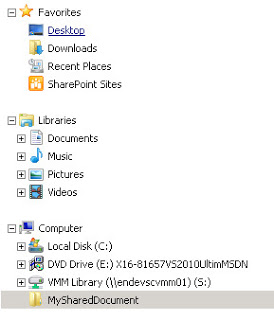There are a number of articles talking about how to map SharePoint libraries to your local drive, but few of them are in depth, especially on how to set up the prerequisites. I hope this post can provide detailed information for users who need to do this. I will also give an overview and talking about some advantages of mapping SharePoint libraries with local file drive.
Prerequisites
You need to make sure the “WebClient” service is up and running on your server. If this service is disabled or missing on your server, you will have an error saying “The folder you entered does not appear to be valid. Please choose another”
To check if “WebClient” service is in your services list, just open services and see. If it is missing, please follow the steps to make it available:
- Start the Windows Server Manager.
- In the tree view, highlight the Features node.
- In the details pane, click Add Features.
- In the Add Features Wizard, check the Desktop Experience box, and then click next.

- Click Install.
- When the Add Features Wizard has finished, click Close.
- Click ‘Yes’ when promoted to restart the computer.
After that you should be able to see the “WebClient” service is avaliable in your services: And then start ‘WebClient’ service. Now you are ready!

Map SharePoint with file drive
- Open “Windows Explorer” from your server
- Right click on “Computer” icon, select “Map network drive..”
- Click “connect to a web site that you can use to store your documents and pictures”

- In “specify the location of your website”, input the library url where you want to store files (e.g. http://yourwebapplication/Shared%20Documents). Note in lower versions of SharePoint the url can’t contain %20 charactors, so simply change the url as http://yourwebapplication/Shared Documents in this case.
- Give it a name
- Follow the instructor and finish!
After that you will be able to see the folder under your computers: If you just want to quickly open a SharePoint library on your windows explorer, simply reformat your library url and paste into the address bar. For example if the url of your library is http://MySPSite:1234/DocumentLibrary then you should change it to file://MySPSite@1234/DocumentLibrary
Benefits for using this mapping
- You can drag and drop files/folders into the mapped drive and it will be synced to SharePoint library (especially when you are using lower SharePoint versions before SharePoint2013)
- Manage (adding/updating/changing/deleting) files from either SharePoint or file drive
- Leverage version control of SharePoint
- Leverage SharePoint search.
- Security controls



Good guide. However, after mapping it, creating folders and moving files into those folders doesn’t work. Are these known issues? Or just unsupported?
Also the drive stops displaying the items within it after the Resource Throttling limit is reached. There are many instances where a library will have more items than the throttling limit. I use indexes and filters to manage the list, but this doesn’t stop the items from disappearing (they are still there, they are just un-viewable) from the mapped drive.
Do you know how to map a drive on an iPhones? I was able to do it successfully on the computer but not on the iPhones. I need to map a SharePoint drive on the iPhone.
Tiffany, the only way right now would be to use OneDrive, and even then with limitations: at present OneDrive can only sync your “My Site” documents onto your device or open single documents via a URL from another Document Library.
Simon, we need to be able to have a Project Manager open an invoice from SharePoint, electronically sign the invoice in Adobe Reader and then save the invoice back to SharePoint. We were able to accomplish this on the computers by mapping the SharePoint to a drive and able to save that way. However, we are having problems getting the invoice saved back to SharePoint on a mobile device. Any ideas?
You could leverage the native SharePoint API in a custom mobile application that supports this, or perhaps look to leverage a third-party offering like DocuSign.
Great guide … thank you!
However, it seems like this solution doesn’t provide a “drive letter” for the mapped drive. So, if we then need to programmatically access the mapped drive (e.g., via another program which needs to access that share), how do we reference it?